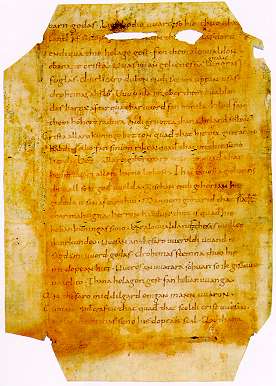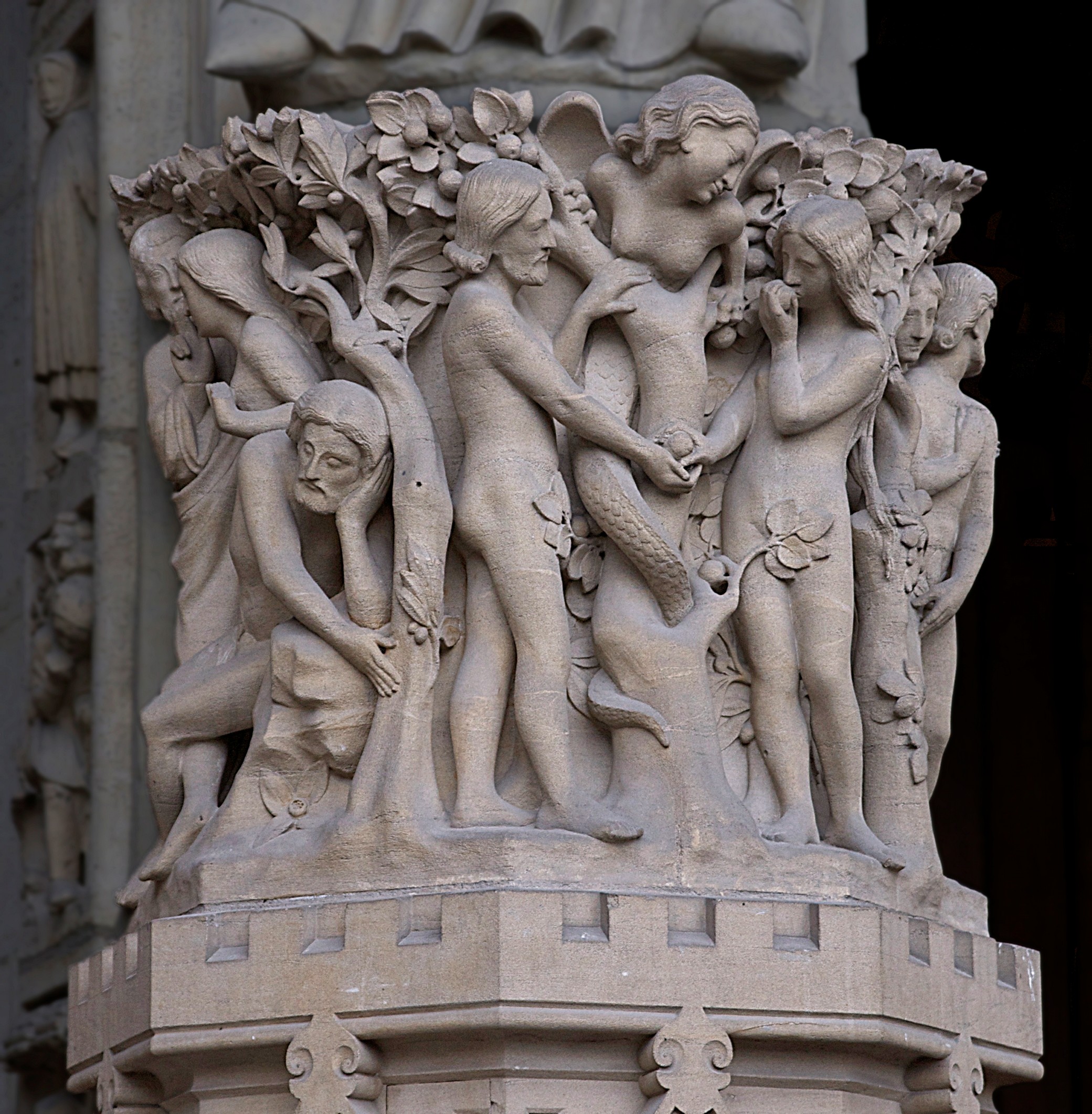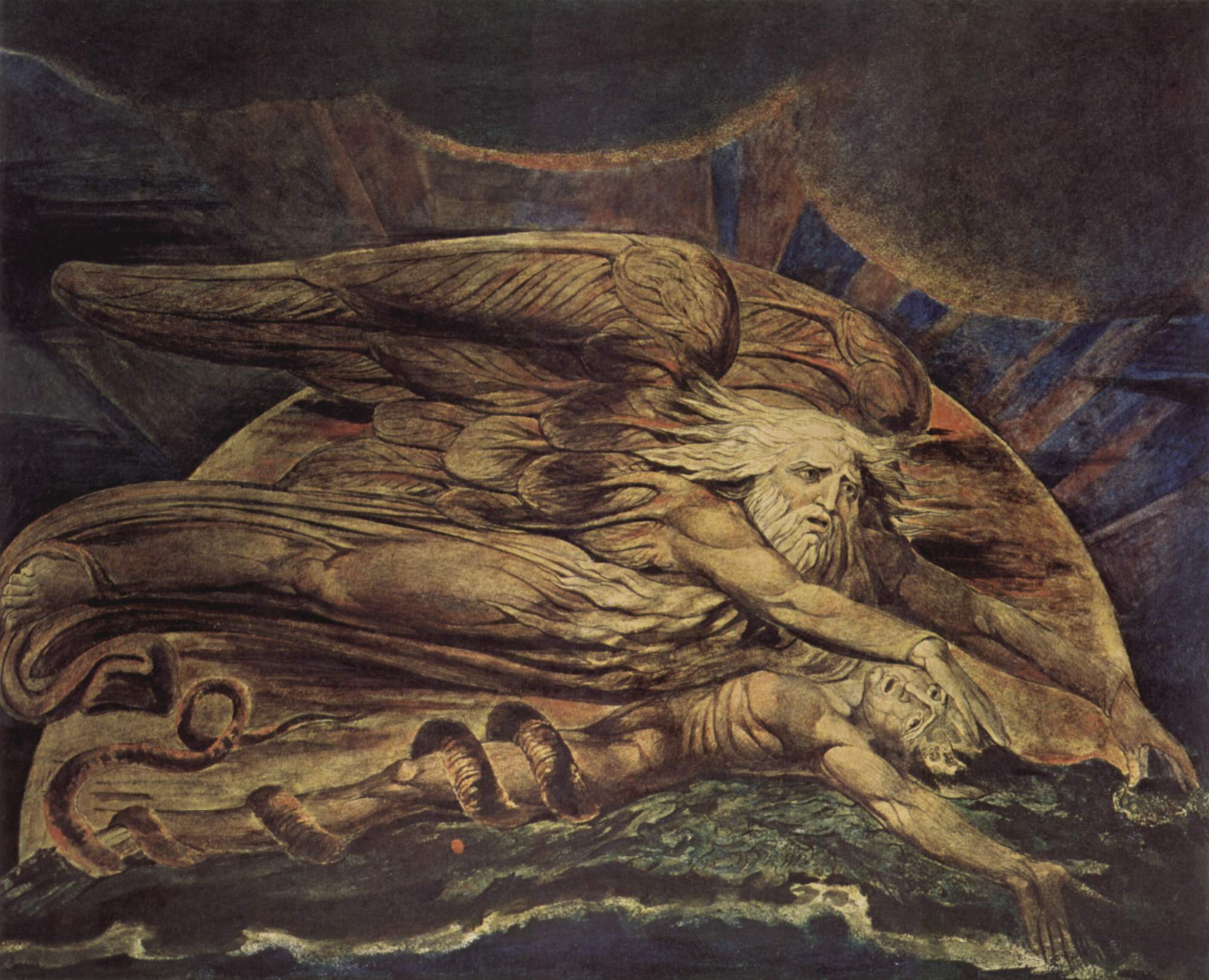|
Old Saxon Genesis
''Genesis'' is an Old Saxon Biblical poem recounting the story of the Book of Genesis, dating to the first half of the 9th century, three fragments of which are preserved in a manuscript in the Vatican Library, ''Palatinus Latinus'' 1447. It and the ''Heliand'', a heroic poem based on the New Testament, a fragment of which is also included in the same manuscript, constitute the only major records of Old Saxon poetry. It is also the basis of the Anglo-Saxon poem known as ''Genesis B'', and Eduard Sievers postulated its existence on linguistic evidence before the manuscript was discovered. Manuscript, dating and provenance ''Palatinus Latinus'' 1447 is a ''computus'' and is assembled from several components, the earliest of which have been dated to around 813 and are shown by internal evidence to have been originally produced at the St. Alban's Abbey in Mainz. The Old Saxon material must have been written down later than an astronomical calculation dated to after 836, and the ''Genes ... [...More Info...] [...Related Items...] OR: [Wikipedia] [Google] [Baidu] |
Old Saxon
Old Saxon (), also known as Old Low German (), was a Germanic language and the earliest recorded form of Low German (spoken nowadays in Northern Germany, the northeastern Netherlands, southern Denmark, the Americas and parts of Eastern Europe). It is a West Germanic language, closely related to the Anglo-Frisian languages. It is documented from the 8th century until the 12th century, when it gradually evolved into Middle Low German. It was spoken throughout modern northwestern Germany, primarily in the coastal regions and in the eastern Netherlands by Saxons, a Germanic tribe that inhabited the region of Saxony. It partially shares Anglo-Frisian's ( Old Frisian, Old English) Ingvaeonic nasal spirant law which sets it apart from Low Franconian and Irminonic languages, such as Dutch, Luxembourgish and German. The grammar of Old Saxon was fully inflected with five grammatical cases ( nominative, accusative, genitive, dative, and instrumental), three grammati ... [...More Info...] [...Related Items...] OR: [Wikipedia] [Google] [Baidu] |
Abbey Of Werden
Werden Abbey () was a Benedictine monastery in Essen-Werden (Germany), situated on the Ruhr. The foundation of the abbey Near Essen Saint Ludger founded a monastery in 799 and became its first abbot. The little church which Saint Ludger built here in honor of Saint Stephen was completed in 804 and dedicated by Saint Ludger himself, who had meanwhile become Bishop of Münster. Upon the death of Ludger on 26 March 809, the abbacy of Werden passed by inheritance first to his younger brother Hildigrim I (809–827), then successively to four of his nephews: Gerfried (827–839), Thiadgrim (ruled less than a year), Altfried (839–848), Hildigrim II (849–887). Under Hildigrim I, also Bishop of Châlons-sur-Marne, the new monastery of Helmstedt in the Diocese of Halberstadt was founded from Werden. It was ruled over by a provost, and remained a dependency of Werden till its secularization in 1803. Werden was a wealthy abbey with possessions in Westphalia, Frisia, eastern Sax ... [...More Info...] [...Related Items...] OR: [Wikipedia] [Google] [Baidu] |
The Journal Of English And Germanic Philology
The ''Journal of English and Germanic Philology'' is a quarterly peer-reviewed academic journal of medieval studies that was established in 1897 and is now published by University of Illinois Press. Its focus is on the cultures of English, Germanic, and Celtic-speaking parts of medieval northern Europe. at Project MUSE. Previous editors-in-chief
An editor-in-chief (EIC), also known as lead editor or chief editor, is a publication's editorial leader who has final responsibility for its operations and policies. T ...
[...More Info...] [...Related Items...] OR: [Wikipedia] [Google] [Baidu] |
Vulgate
The Vulgate () is a late-4th-century Bible translations into Latin, Latin translation of the Bible. It is largely the work of Saint Jerome who, in 382, had been commissioned by Pope Damasus I to revise the Gospels used by the Diocese of Rome, Roman Church. Later, of his own initiative, Jerome extended this work of revision and translation to include most of the books of the Bible. The Vulgate became progressively adopted as the Bible text within the Western Church. Over succeeding centuries, it eventually eclipsed the texts. By the 13th century it had taken over from the former version the designation (the "version commonly used") or for short. The Vulgate also contains some ''Vetus Latina'' translations that Jerome did not work on. The Catholic Church affirmed the Vulgate as its official Latin Bible at the Council of Trent (1545–1563), though there was no single authoritative edition of the book at that time in any language. The Vulgate did eventually receiv ... [...More Info...] [...Related Items...] OR: [Wikipedia] [Google] [Baidu] |
Cain And Abel
In the biblical Book of Genesis, Cain and Abel are the first two sons of Adam and Eve. Cain, the firstborn, was a farmer, and his brother Abel was a shepherd. The brothers made sacrifices, each from his own fields, to God. God had regard for Abel's offering, but had no regard for Cain's. Cain killed Abel and God cursed Cain, sentencing him to a life of transience. Cain then dwelt in the land of Nod (), where he built a city and fathered the line of descendants beginning with Enoch. The New Testament Epistle to the Hebrews interprets Abel’s sacrifice as more acceptable than Cain’s because it was offered in faith, earning Abel God’s approval. In the Qur'an, Cain and Abel are known as Qābīl () and Hābīl (), respectively. In Islamic tradition, the story of Cain and Abel portrays Cain as the first murderer driven by jealousy and lust, guided by the devil, and punished with guilt and disgrace, with some scholars debating the identity and motives of the brothers. In the ... [...More Info...] [...Related Items...] OR: [Wikipedia] [Google] [Baidu] |
Sodom And Gomorrah
In the Abrahamic religions, Sodom and Gomorrah () were two cities destroyed by God for their wickedness. Sodom and Gomorrah are repeatedly invoked throughout the Hebrew Bible, Deuterocanonical texts, and the New Testament as symbols of sin, divine judgment, and destruction, serving as moral warnings and eschatological parallels. The Quran also contains a version of the story about the two cities. In the biblical narrative, Sodom and Gomorrah, rebellious cities once defeated by Chedorlaomer, were destroyed by God because of their great wickedness. Lot and his daughters were spared when angels led them to safety, but Lot’s wife was turned into a pillar of salt for looking back against the angels’ warning. Their story parallels the Genesis flood narrative in its theme of God's anger provoked by man's sin (see Genesis 19:1–28). The story of Sodom, originally associated with inhospitality, arrogance, and injustice, was later reinterpreted—especially in Christian theol ... [...More Info...] [...Related Items...] OR: [Wikipedia] [Google] [Baidu] |
Abraham
Abraham (originally Abram) is the common Hebrews, Hebrew Patriarchs (Bible), patriarch of the Abrahamic religions, including Judaism, Christianity, and Islam. In Judaism, he is the founding father who began the Covenant (biblical), covenantal relationship between the Jewish people and God in Judaism, God; in Christianity, he is the spiritual progenitor of all believers, whether Jewish or gentile, non-Jewish; and Abraham in Islam, in Islam, he is a link in the Prophets and messengers in Islam, chain of Islamic prophets that begins with Adam in Islam, Adam and culminates in Muhammad. Abraham is also revered in other Abrahamic religions such as the Baháʼí Faith and the Druze, Druze faith. The story of the life of Abraham, as told in the narrative of the Book of Genesis in the Hebrew Bible, revolves around the themes of posterity and land. He is said to have been called by God to leave the house of his father Terah and settle in the land of Canaan, which God now promises to Ab ... [...More Info...] [...Related Items...] OR: [Wikipedia] [Google] [Baidu] |
Fall Of Man
The fall of man, the fall of Adam, or simply the Fall, is a term used in Christianity to describe the transition of the first man and woman from a state of innocent obedience to God in Christianity, God to a state of guilty disobedience. * * * * The doctrine of the Fall comes from a biblical interpretation of Book of Genesis, Genesis, chapters 1–3. At first, Adam and Eve lived with God in the Garden of Eden, but the Serpents in the Bible, serpent tempted them into Taboo#In religion and mythology, eating the Forbidden fruit, fruit from the tree of knowledge of good and evil, which God had forbidden. After doing so, they became ashamed of their nakedness and God expelled them from the Garden to prevent them from eating the fruit of the Tree of life (biblical), tree of life and becoming Immortality, immortal. In Nicene Christianity, mainstream (Nicene) Christianity, the doctrine of the Fall is closely related to that of original sin or ancestral sin. Nicene Christians believe that ... [...More Info...] [...Related Items...] OR: [Wikipedia] [Google] [Baidu] |
Adam
Adam is the name given in Genesis 1–5 to the first human. Adam is the first human-being aware of God, and features as such in various belief systems (including Judaism, Christianity, Gnosticism and Islam). According to Christianity, Adam sinned in the Garden of Eden by eating from the tree of the knowledge of good and evil. This action introduced death and sin into the world. This sinful nature infected all his descendants, and led humanity to be expelled from the Garden. Only through the crucifixion of Jesus, humanity can be redeemed. In Islam, Adam is considered '' Khalifa'' (خليفة) (successor) on earth. This is understood to mean either that he is God's deputy, the initiation of a new cycle of sentient life on earth, or both. Similar to the Biblical account, the Quran has Adam placed in a garden where he sins by taking from the Tree of Immortality, so loses his abode in the garden. When Adam repents from his sin, he is forgiven by God. This is seen as a guidan ... [...More Info...] [...Related Items...] OR: [Wikipedia] [Google] [Baidu] |
Wilhelm Braune
Theodor Wilhelm Braune (20 February 1850 in Großthiemig, Province of Saxony – 10 November 1926 in Heidelberg) was a German philologist and Germanist. Biography In 1869 Braune entered the University of Leipzig, where he was approved as an instructor in 1874. In 1877 he was appointed as extraordinary professor at the University of Giessen and became an ordinary professor of German language and literature there in 1880. He later served as a professor at the University of Heidelberg. He is an important representative of the Neogrammarians. Among his most lasting achievements were his works on the history of the Germanic languages. Editions of his grammars and anthologies of Old High German and Gothic are still in use today. In 1873 he also founded, together with Hermann Paul, the Germanic studies journal '' Beiträge zur Geschichte der deutschen Sprache und Literatur'' often referred to among scholars as ''Pauls und Braunes Beiträge'' (or ''PBB'') and which remains one of the ... [...More Info...] [...Related Items...] OR: [Wikipedia] [Google] [Baidu] |
Karl Breul
Karl may refer to: People * Karl (given name), including a list of people and characters with the name * Karl der Große, commonly known in English as Charlemagne * Karl of Austria, last Austrian Emperor * Karl (footballer) (born 1993), Karl Cachoeira Della Vedova Júnior, Brazilian footballer * Karl (surname) In myth * Karl (mythology), in Norse mythology, a son of Rig and considered the progenitor of peasants (churl) * ''Karl'', giant in Icelandic myth, associated with Drangey island Vehicles * Opel Karl, a car * ST ''Karl'', Swedish tugboat requisitioned during the Second World War as ST ''Empire Henchman'' Other uses * Karl, Germany, municipality in Rhineland-Palatinate, Germany * ''Karl-Gerät'', AKA Mörser Karl, 600mm German mortar used in the Second World War * KARL project, an open source knowledge management system * Korean Amateur Radio League, a national non-profit organization for amateur radio enthusiasts in South Korea * KARL, a radio station in Minnesota * Li ... [...More Info...] [...Related Items...] OR: [Wikipedia] [Google] [Baidu] |







